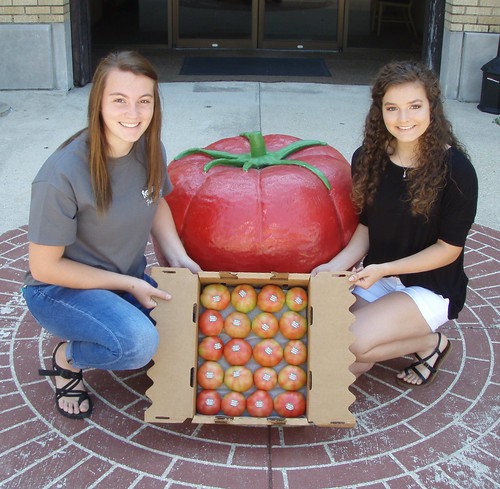After an April of freeze and frost, first tomatoes come in for southeast Arkansas
By Ryan McGeeney
U of A System Division of Agriculture
June 1, 2018
Fast Facts:
- First box of tomatoes called in to Bradley County CES May 27
- A rough April did damage to leaders, but auxiliary buds still producing
- Ashley-Drew-Bradley county area produces most of state’s commercial tomatoes
(482 words)
(Download this story in MS Word format here.)
BRADLEY COUNTY, Ark. – With one phone call on May 27, the question of whether Arkansas would have any tomatoes of which to speak in 2018 was answered.
That Sunday, members of Clanton Farms in Hermitage, Ark., called in to the Bradley County Cooperative Extension Service office to say that the first box of Amelia tomatoes had been assembled for sale.
John Gavin, staff chair Bradley County CES office, said the call came at a time when some people, looking at both the calendar and the weather for this past April, were wondering if the state would see any tomatoes in time for te Pink Tomato Festival.
An outright freeze on April 8, followed by a hard frost April 15, took its toll on tomato tops across Ashley, Drew and Bradley counties — the tri-county area that represents nearly all of the state’s 800-850 commercial tomato acres.
“We’re actually running a little behind, due to the cold weather we had in April,” Gavin said. “But the warm weather’s helping us progress. We’re hoping to catch up.”
Gavin said that the first box to be brought or called in to an extension office is usually a sign that the rest of the crop will begin steadily rolling in. But, as is the case with some many aspects of agriculture in Arkansas over the last few years, this year may prove somewhat different.
Clanton Farms is perhaps the single largest tomato producer in the state, with 200-250 acres dedicated to tomato production, Gavin said, representing about a quarter of the state’s overall commercial tomato production. He said the first box was picked from one of the farm’s earlier-planted fields.
“Other farms are running a little behind the Clantons,” Gavin said.
As with many crops in Arkansas, large acreage allows for staggered planting, and hence a staggered harvest. While this is in part a limitation of manpower, it also helps diversify a crop’s growth stages, which can help it survive a rough weather event that occurs at a critical stage of plant development. But with such a short window (southeastern Arkansas tomatoes are typically planted in late March or early April, and harvest typically begins in late May or early June), a late freeze — followed by a frost and overall relatively cool temperatures — can leave its mark on everything on the farm.
“There’s no way of telling until you start picking,” Gavin said. “We are running later, no doubt about it. The crop had to be worked out of the damage. Tomatoes produce auxiliary buds that can make a new top. So if you lose a top, the main leader, you can grow another from one of the prunes or suckers. But that just takes time.
“Over all, the crop is looking good,” he said. “There’s a good fruit load, but maturity wise, we’re just a little behind, but catching up fast.”
To learn about tomatoes in Arkansas, contact your local Cooperative Extension Service agent or visit www.uaex.uada.edu.
About the Division of Agriculture
The University of Arkansas System Division of Agriculture’s mission is to strengthen agriculture, communities, and families by connecting trusted research to the adoption of best practices. Through the Agricultural Experiment Station and the Cooperative Extension Service, the Division of Agriculture conducts research and extension work within the nation’s historic land grant education system.
The Division of Agriculture is one of 20 entities within the University of Arkansas System. It has offices in all 75 counties in Arkansas and faculty on five system campuses.
Pursuant to 7 CFR § 15.3, the University of Arkansas System Division of Agriculture offers all its Extension and Research programs and services (including employment) without regard to race, color, sex, national origin, religion, age, disability, marital or veteran status, genetic information, sexual preference, pregnancy or any other legally protected status, and is an equal opportunity institution.
# # #
Media Contact: Ryan McGeeney
Communication Services
U of A System Division of Agriculture
Cooperative Extension Service
(501) 671-2120
rmcgeeney@uada.edu
